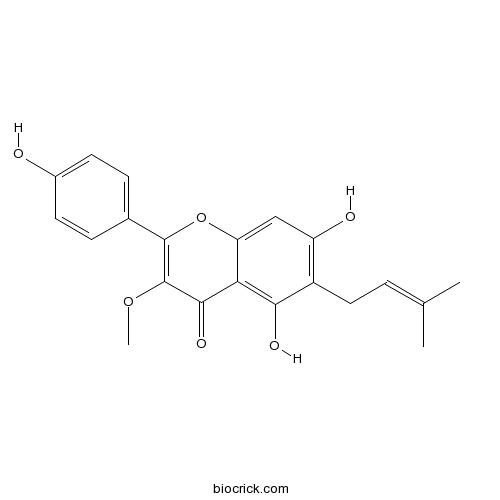TopazolinCAS# 109605-79-0 |

Quality Control & MSDS
3D structure
Package In Stock
Number of papers citing our products

| Cas No. | 109605-79-0 | SDF | Download SDF |
| PubChem ID | 5481965 | Appearance | Powder |
| Formula | C21H20O6 | M.Wt | 368.39 |
| Type of Compound | Flavonoids | Storage | Desiccate at -20°C |
| Solubility | Soluble in Chloroform,Dichloromethane,Ethyl Acetate,DMSO,Acetone,etc. | ||
| Chemical Name | 5,7-dihydroxy-2-(4-hydroxyphenyl)-3-methoxy-6-(3-methylbut-2-enyl)chromen-4-one | ||
| SMILES | CC(=CCC1=C(C=C2C(=C1O)C(=O)C(=C(O2)C3=CC=C(C=C3)O)OC)O)C | ||
| Standard InChIKey | VVXGFIWLFZMBCJ-UHFFFAOYSA-N | ||
| Standard InChI | InChI=1S/C21H20O6/c1-11(2)4-9-14-15(23)10-16-17(18(14)24)19(25)21(26-3)20(27-16)12-5-7-13(22)8-6-12/h4-8,10,22-24H,9H2,1-3H3 | ||
| General tips | For obtaining a higher solubility , please warm the tube at 37 ℃ and shake it in the ultrasonic bath for a while.Stock solution can be stored below -20℃ for several months. We recommend that you prepare and use the solution on the same day. However, if the test schedule requires, the stock solutions can be prepared in advance, and the stock solution must be sealed and stored below -20℃. In general, the stock solution can be kept for several months. Before use, we recommend that you leave the vial at room temperature for at least an hour before opening it. |
||
| About Packaging | 1. The packaging of the product may be reversed during transportation, cause the high purity compounds to adhere to the neck or cap of the vial.Take the vail out of its packaging and shake gently until the compounds fall to the bottom of the vial. 2. For liquid products, please centrifuge at 500xg to gather the liquid to the bottom of the vial. 3. Try to avoid loss or contamination during the experiment. |
||
| Shipping Condition | Packaging according to customer requirements(5mg, 10mg, 20mg and more). Ship via FedEx, DHL, UPS, EMS or other couriers with RT, or blue ice upon request. | ||
| Description | 1. Topazolin has weak fungitoxic activity. 2. Topazolin displays significant activity against Salmonella typhimurium ATCC 13311 with MIC values ranging from 2 to 8 ug/mL, it also shows in vitro free radical scavenging activities with IC50 values in the range of 0.18-0.56 mg/mL. |
| Targets | Antifection |

Topazolin Dilution Calculator

Topazolin Molarity Calculator
| 1 mg | 5 mg | 10 mg | 20 mg | 25 mg | |
| 1 mM | 2.7145 mL | 13.5726 mL | 27.1451 mL | 54.2903 mL | 67.8629 mL |
| 5 mM | 0.5429 mL | 2.7145 mL | 5.429 mL | 10.8581 mL | 13.5726 mL |
| 10 mM | 0.2715 mL | 1.3573 mL | 2.7145 mL | 5.429 mL | 6.7863 mL |
| 50 mM | 0.0543 mL | 0.2715 mL | 0.5429 mL | 1.0858 mL | 1.3573 mL |
| 100 mM | 0.0271 mL | 0.1357 mL | 0.2715 mL | 0.5429 mL | 0.6786 mL |
| * Note: If you are in the process of experiment, it's necessary to make the dilution ratios of the samples. The dilution data above is only for reference. Normally, it's can get a better solubility within lower of Concentrations. | |||||

Calcutta University

University of Minnesota

University of Maryland School of Medicine

University of Illinois at Chicago

The Ohio State University

University of Zurich

Harvard University

Colorado State University

Auburn University

Yale University

Worcester Polytechnic Institute

Washington State University

Stanford University

University of Leipzig

Universidade da Beira Interior

The Institute of Cancer Research

Heidelberg University

University of Amsterdam

University of Auckland

TsingHua University

The University of Michigan

Miami University

DRURY University

Jilin University

Fudan University

Wuhan University

Sun Yat-sen University

Universite de Paris

Deemed University

Auckland University

The University of Tokyo

Korea University
- Pinocembrin 7-acetate
Catalog No.:BCN5887
CAS No.:109592-60-1
- Tacrolimus monohydrate
Catalog No.:BCC5284
CAS No.:109581-93-3
- RX 821002 hydrochloride
Catalog No.:BCC7021
CAS No.:109544-45-8
- CCT137690
Catalog No.:BCC2188
CAS No.:1095382-05-0
- ARQ 621
Catalog No.:BCC6534
CAS No.:1095253-39-6
- Rac1 Inhibitor W56
Catalog No.:BCC5886
CAS No.:1095179-01-3
- PF-04449913
Catalog No.:BCC5154
CAS No.:1095173-27-5
- JNJ-31020028
Catalog No.:BCC5516
CAS No.:1094873-14-9
- 3'-Methyl-4-O-methylhelichrysetin
Catalog No.:BCN4062
CAS No.:109471-13-8
- BIX 02189
Catalog No.:BCC2549
CAS No.:1094614-85-3
- BIX 02188
Catalog No.:BCC2550
CAS No.:1094614-84-2
- Fmoc-His(Trt)-OPfp
Catalog No.:BCC3502
CAS No.:109434-24-4
- Neocryptotanshinone
Catalog No.:BCN3158
CAS No.:109664-02-0
- SPK-601
Catalog No.:BCC1961
CAS No.:1096687-52-3
- MLN 2480
Catalog No.:BCC1771
CAS No.:1096708-71-2
- Murraol
Catalog No.:BCN5888
CAS No.:109741-38-0
- cis-Dehydroosthol
Catalog No.:BCN4735
CAS No.:109741-40-4
- 8 beta-(4-Acetoxy-5-hydroxytigloyloxy)costunolide
Catalog No.:BCN7123
CAS No.:109770-86-7
- Homopahutoxin
Catalog No.:BCN1812
CAS No.:109777-68-6
- 9R-10alpha-Hydroxyepigambogic acid
Catalog No.:BCN3079
CAS No.:1097882-33-1
- ASP3026
Catalog No.:BCC1372
CAS No.:1097917-15-1
- Harmalidine
Catalog No.:BCN5889
CAS No.:109794-97-0
- Kaempferol 5,7,4'-trimethyl ether
Catalog No.:BCN6587
CAS No.:1098-92-6
- CGS 9343B
Catalog No.:BCC7303
CAS No.:109826-27-9
Prenylated polyphenolic compounds from Glycyrrhiza iconica and their antimicrobial and antioxidant activities.[Pubmed:25963162]
Fitoterapia. 2015 Jun;103:289-93.
A new prenylated isoflavan, iconisoflavan (1), and a new prenylated isoflav-3-ene, iconisoflaven (2) were isolated from the roots of Glycyrrhiza iconica together with four known ones namely (3S)-licoricidin (3), licorisoflavan A (4), Topazolin (5) and glycycoumarin (6). The structures were elucidated on the basis of extensive spectroscopic analysis including 1D and 2D NMR as well as HR-MS. Furthermore, the absolute configurations of compounds 1, 3 and 4 were established by electronic circular dichroism (ECD). All the isolated compounds (1-6) were evaluated for their in vitro antimicrobial activities against five pathogenic bacteria and one yeast (Candida albicans) using an in vitro microdilution method. Compounds 1 and 3-5 displayed significant activity against Salmonella typhimurium ATCC 13311 with MIC values ranging from 2 to 8 mug/mL. Additionally, all compounds were screened for their in vitro free radical scavenging activities using an in vitro microdilution DPPH assay spectrofotometrically. The tested compounds exhibited IC50 values in the range of 0.18-0.56 mg/mL, suggesting an activity comparable with that of ascorbic acid (IC50: 0.07 mg/mL). To the best of our knowledge, the present study constitutes the first phytochemical and bioactivity investigation on G. iconica.


